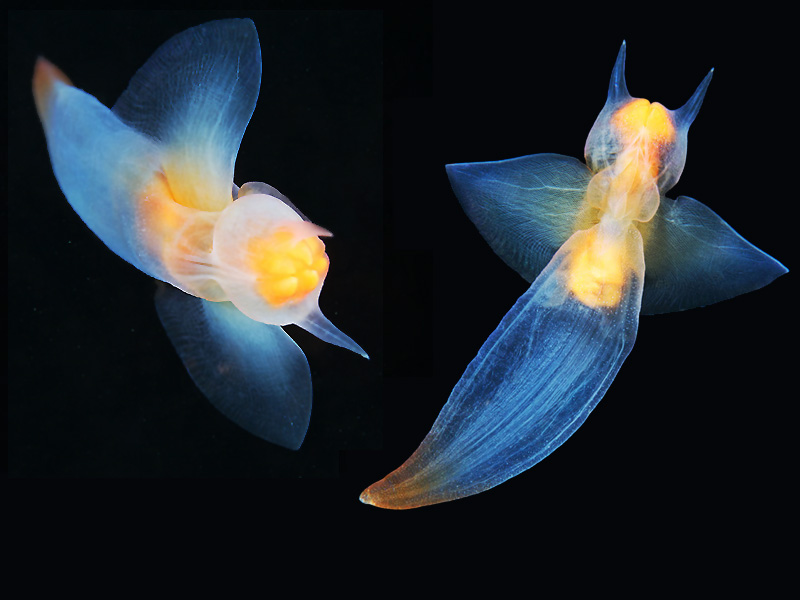Sea angels, also known as Gymnosomata, are captivating creatures that inhabit the world's oceans. These ethereal beings, often resembling delicate angels of the sea, belong to the group of pelagic sea slugs. Despite their diminutive size, sea angels boast a remarkable array of adaptations that enable them to thrive in their marine environment. Here are 20 fascinating facts about these enchanting creatures:
- Pelagic Predators:
Sea angels are pelagic, meaning they live in open ocean waters rather than near the ocean floor like most other sea slugs. - Unique Anatomy:
Unlike their close relatives, sea butterflies, sea angels lack shells. Instead, they have a translucent, gelatinous body, allowing them to blend seamlessly into their surroundings. - Angel-Like Appearance:
With their graceful, wing-like appendages and radiant appearance, sea angels indeed resemble celestial beings, hence their poetic name. - Size Variation:
Sea angels vary in size, with some species measuring only a few millimeters in length, while others can reach up to several centimeters. - Bioluminescence:
Certain species of sea angels possess the remarkable ability to produce bioluminescent light, which they use for communication and defense. - Swimming Techniques:
Sea angels employ a unique mode of locomotion called "flapping-swimming," where they undulate their wing-like structures to propel themselves through the water. - Coldwater Dwellers:
Sea angels are primarily found in cold, polar regions, although some species inhabit temperate and tropical waters as well. - Feeding Habits:
These carnivorous creatures feed primarily on other pelagic organisms, such as small crustaceans and the larvae of other marine invertebrates. - Mating Rituals:
Sea angels engage in elaborate mating rituals, often involving intricate displays of courtship behavior and the exchange of gametes. - Hermaphroditic Reproduction:
Most sea angels are hermaphrodites, possessing both male and female reproductive organs. This enables them to fertilize each other during mating encounters. - Short Lifespan:
Despite their otherworldly appearance, sea angels have relatively short lifespans, typically living for only a few months to a year. - Predator-Prey Relationships:
Despite their delicate appearance, sea angels are skilled predators, preying on smaller organisms while also falling victim to larger predators such as fish and marine mammals. - Symbiotic Relationships:
Some species of sea angels engage in symbiotic relationships with other marine organisms, providing transportation or protection in exchange for food or shelter. - Taxonomic Diversity:
The group Gymnosomata encompasses a diverse array of species, with scientists estimating anywhere from 80 to 100 different species of sea angels worldwide. - Ancient Origins:
Sea angels have a long evolutionary history, with fossil records dating back millions of years, providing insights into their ancient origins and evolutionary adaptations. - Sensitive to Environmental Changes:
Like many marine organisms, sea angels are sensitive to changes in their environment, including fluctuations in temperature, acidity, and pollution levels. - Research Importance:
Despite their small size, sea angels play a crucial role in marine ecosystems and serve as important indicators of ocean health. Studying them can provide valuable insights into the broader impacts of climate change and human activities on marine life. - Conservation Concerns: As with many marine species, sea angels face threats from habitat destruction, overfishing, pollution, and climate change. Conservation efforts are essential to protect these enchanting creatures and the ecosystems they inhabit.
- Scientific Exploration:
Advances in technology, such as underwater robotics and high-resolution imaging, have enabled scientists to conduct more in-depth studies of sea angels and their habitats, uncovering new discoveries about their behavior and ecology. - Inspiration for Art and Literature:
The mesmerizing beauty and mysterious nature of sea angels have inspired artists, writers, and poets throughout history, contributing to their enduring fascination and allure in popular culture.
In conclusion, sea angels are truly extraordinary creatures that embody the wonder and diversity of marine life. As we continue to explore and protect our oceans, these enchanting beings serve as a reminder of the fragile beauty and interconnectedness of the underwater world.


.jpg)







0 Comments